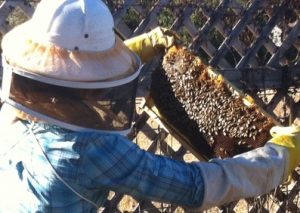Until about a year ago, when I thought “bee”, I thought “honey bee”. I had no idea North American bees did all the pollination on this continent until the Europeans arrived with honey bees, nor did I know honey bees aren’t very good at pollinating tomatoes, eggplants, pumpkins and watermelons, blueberries and cranberries, also natives. Native bees live in the ground, in logs and swamps; the majority are solitary. When I wrote in my earlier post, The Living Soil, that walking on the earth was walking on many forms of underground life, I had not thought about bees, who drill down and feed their babies in underground tunnels.
Of course, native bees are stressed by plowing, clear-cut logging and draining swamps. Along with their cousins, the honey bees, they suffer from toxic chemicals. Honey bees also currently endure disease and overwork when they are loaded on to trucks to provide pollination to big corporate farms–a discussion saved for Part 2, next week.
This week, I have to confess that my attempts to keep honey bees have not been a great success. Even though humans have been keeping bees for over 20,000 years, I have no feel for them, no instinct for their needs. I think I have more in insight into the needs of handful of dirt than a bee. After losing several hives, I now have a beekeeper, Tara Chapman https://www.twohiveshoney.com
Tara said this past week that my current hive is very vigorous and the bees have plenty of honey for the winter, but none to harvest. In October, she casually handed me four full frames, I stood each frame in a bowl, cut through the wax  with a butter knife and waited for the honey to flow out. Then I strained it (large strainer to leave in the pollen) and put the “raw” unfiltered, unheated honey in jars. Lovely. A gallon and a half.
with a butter knife and waited for the honey to flow out. Then I strained it (large strainer to leave in the pollen) and put the “raw” unfiltered, unheated honey in jars. Lovely. A gallon and a half.
Tara attends to the bees in jeans and a flannel shirt with her bee hat and gloves. The bees circle her benignly. It’s fun to watch someone Who Knows What They are Doing. You can see her pulling a frame from the hive here that is covered with bees. 
Do not imagine that I recommend anything other than a full bee suit for going into a hive. The favorite bee here and in Europe has been the Italian bee, docile and a producer over a long season. I have seen people caring for Italian bees in shorts. But in the 1980’s the tracheal and varroa mites began to decimate the bee population. That issue for me is mitigated by buying my bees from BeeWeaver Apiaries, based in Texas. In the 1990’s BeeWeaver found their bee stock had been significantly affected by African bees, who were able to fend off these terrible mites. http://www.beeweaver.com/faq-cats/beeweaver-and-our-breed. The trade-off was that the “africanized” bees repel mites who come into their hive, but also humans who do so. BeeWeaver and other apiaries are breeding for a gentle bee that repels mites.
I have found that unless someone is going into their hive, my bees are perfectly good farm residents. Before I got my full bee suit, I was stung on several occasions going into the hive and did not find it to be a big deal; fire ant stings are much worse. My goals now are, first, to learn enough to be able to go comfortably into the hives and understand what I am looking at. Second, Tara and I have agreed that I have space for two more hives and she will set those up in the spring. If I have multiple hives I have to mark each with a symbol or paint each a different color so the bees will not mistake their home hive. I imagine pink and blue and yellow hives; maybe green. Carribean colors. And honey, I imagine lots of honey.
Note: Here is the website of a neighbor, very interesting and informative: http://blog.auldridge.org/2009/06/28/busy-as-bees/